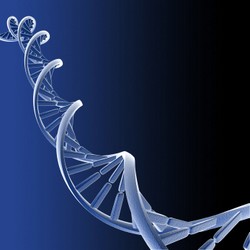
A trio of groundbreaking publications from researchers in Northwestern University’s Physical Sciences-Oncology Center (PS-OC) report important methodological advances that will enable a better understanding of how gene expression is regulated, both in normal cells and in cancer cells. This knowledge could lead to the development of more effective therapeutic agents to treat cancer patients.
The three papers, published recently in the journals Nature Genetics, Nature Biotechnology, and Nature, focus on nucleosomes, a basic unit of DNA packaging, and may help to uncover the rules governing gene transcription.
The late Jonathan Widom of Northwestern is senior author of the Nature paper that describes a new method for mapping nucleosomes. His longtime collaborator Eran Segal of the Weizmann Institute in Israel is senior author of two papers that build on his and Widom’s earlier discovery of a “second DNA code.”
“It is becoming increasingly clear that acquired mutations in the machinery that underlies the way in which DNA is packaged into chromatin are major drivers of the development of tumors in humans,” said Jonathan Licht, MD, the Northwestern PS-OC’s senior investigator. Chromatin is a complex of DNA and proteins that when compacted forms chromosomes.
“The work of the PS-OC, including these new studies, has allowed the elucidation of the normal rules by which chromatin is arranged in the cell,” he said. “This will help us to understand what’s going wrong in cancer and how that might be remedied,” said Licht, the Johanna Dobe Professor and chief of the division of hematology/oncology at Northwestern University Feinberg School of Medicine and an associate director of the Robert H. Lurie Comprehensive Cancer Center of Northwestern University.
Six years ago, Widom and Segal reported in Nature the discovery of a second DNA code that explains the placement of nucleosomes, spool-like structures in which the DNA loops around a protein complex. (The first code is DNA’s genetic code, which specifies the composition of cellular proteins.) Nucleosomes control access to the DNA. Widom and Segal found that there are certain DNA sequences that favor or disfavor the location of these nucleosomes.
Widom, whose research focused on chromatin packaging and gene regulation, and Segal, a computational biologist, continued their studies on sequence preferences for nucleosome formation as part of a project funded by PS-OC.
Widom directed the center until his untimely death last year, and was the William Deering Professor of Molecular Biosciences in the Weinberg College of Arts and Sciences. Segal has been a member of the center since its inception in 2009.
“This new work of Jon Widom’s lab, reported in Nature, adds greatly to the ability to measure the locations of nucleosomes with unprecedented accuracy, which is needed to decipher the code in the DNA as reported in our two recent papers,” Segal said.
In the papers by the Segal group, one in Nature Genetics and the other in Nature Biotechnology, Segal and his colleagues developed an elegant experimental system that allows them to accurately measure the effects of DNA sequences that disfavor the formation of nucleosomes on transcriptional regulation.
The new technology makes it possible to simultaneously introduce tens of thousands of DNA regions into tens of thousands of living cells – each region in a separate cell – in a planned and systematic manner, and to measure the results of each such change with great precision and within a single experiment.
Using this system, the Segal group demonstrated that sequences favoring the formation of nucleosomes do indeed have a significantly negative impact on transcription. Transcription is the copying of specific sequences in the DNA into similar molecules called RNA, which are intermediaries in the flow of information between the DNA and protein production. Both of the Segal papers acknowledge the intellectual contribution of Widom to their work.
The third paper, published in Nature and reporting on work completed in the Widom laboratory after his death, describes another major methodological advance. This novel technique permits the location of nucleosomes in the genome to be mapped with much higher accuracy than was previously possible. Not only will this technique enable a much better understanding of transcriptional regulation, but it should also help scientists to understand other features of DNA biology.
Ji-Ping Wang, who directs the bioinformatics core of the PS-OC, played a major role in the development of this technique.
“This is another example of how Jon’s great knowledge in biochemistry and biophysics allowed him to suggest a way to scale up an existing experimental technique into modern tools that would allow genome-wide mapping of nucleosomes,” Segal said. “Jon also was closely involved in our work and provided invaluable insights and suggestions into all aspects of the research.”
The Northwestern Physical Sciences-Oncology Center focuses on applying physical sciences approaches to understanding the fundamental principles underlying aberrant gene expression in cancer. Funded by the National Cancer Institute, the center is a collaboration of the Chemistry of Life Processes Institute and the Robert H. Lurie Comprehensive Cancer Center of Northwestern University.






